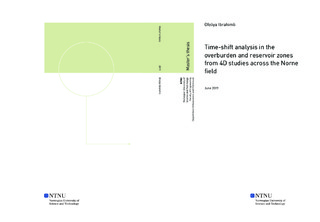| dc.description.abstract | 4D seismic is a powerful tool, mainly used for monitoring the changes in the reservoir and overburden zones that might occur due to hydrocarbon production or EOR-related changes. The observed changes on 4D seismic can be correlated with the data acquired from the wells and the analysis could be performed. Identification of hidden oil and gas pockets, pressure barriers and effects of water injection on 4D can be helpful in implementation in reservoir models and when planning new wells, thus, increasing well success rates and reducing the risks of well-drilling problems.
This master thesis is focused towards time-shift analysis in overburden and reservoir zones over Norne field, using time-lapse seismic dataset from 2001 and 2006. The main aim is to prove if quantified travel-time changes across overburden and within reservoir section correlate, appear consistent and are real and not random noise.
The data was analyzed using Method 1, Method 2 and cross-correlation technique. In Method 1, the seafloor is kept constant as a reference horizon and time-shifts and relative time-shifts are calculated from seafloor down to each interpreted horizon. In Method 2, the time-shifts and relative time-shifts are calculated from one interpreted horizon to another one. Cross-correlation technique was used to define the similarity between two seismic volumes and to inspect the reservoir and overburden zones. Overall, it could be concluded that the latter is best to use to examine the regional change in travel-time, whereas Method 1 and Method 2 are more convenient to observe local changes.
C-, E- and G- segments in Norne field were analyzed and it was presumed that more than one 4D effect (pressure and saturation changes) has an impact on the seismic response, which makes the interpretation of the time-shift behaviour more complicated. Decrease and/or increase of pore pressure, gas going out and coming back to oil, water injection effects in different segments of reservoir zone are affecting the velocities and, thus, time-shifts. These physical changes disturb the stress field of the rocks surrounding the reservoir interval and propagate to overburden and underburden, resulting in velocity and travel-time variations. | |
